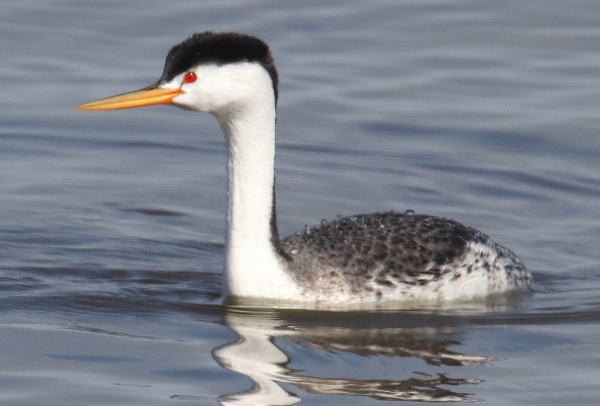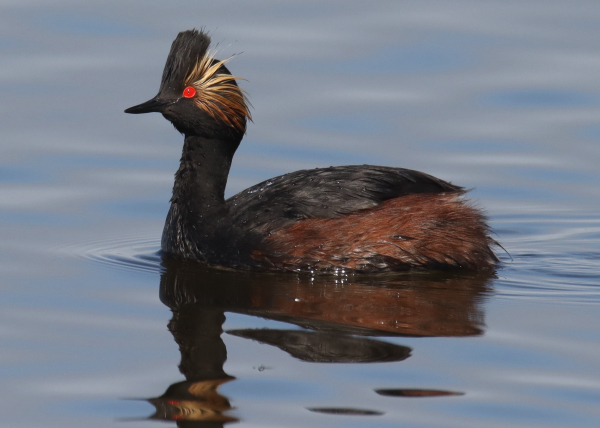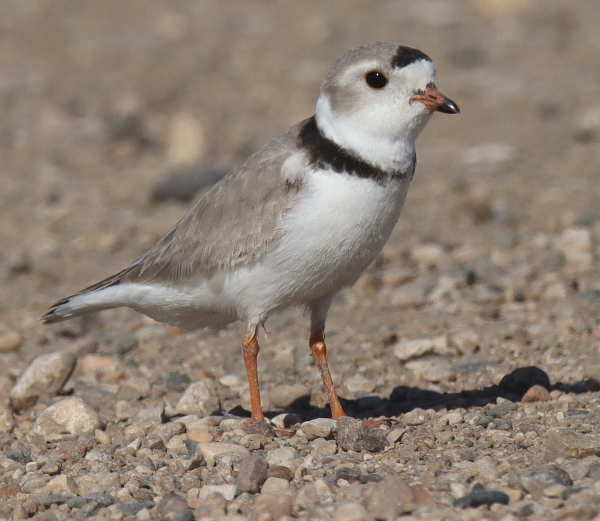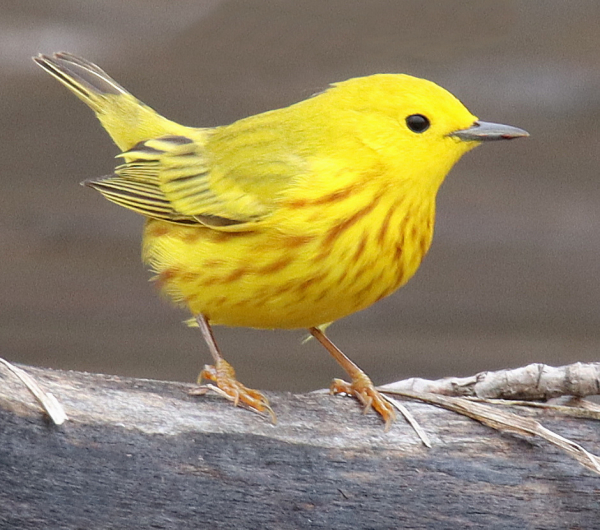
The first Long Lake Refuge surprise was a Clark’s Grebe – close!

Eared Grebes were the most common photo subjects along the Long Lake route, although there was a wealth of birds to observe.

The biggest surprise was a Piping Plover that created a very big photo challenge, seemingly insurmountable, but the fruitful outcome is evidenced by the above photo, along with others that illustrate the Bird Photography feature.

The first fallout warbler of the year was a colorful male Yellow Warbler, the first of many to follow.
|
After seeing the birds on hand during my previous week’s visit to Long Lake National Wildlife Refuge, I couldn’t wait to get back during a sunny day, which was last Wednesday. I made the bird-rich refuge my sole destination that day as a photography destination, expecting the variety of grebes and ducks to be my primary interests, but there was no way of predicting the excitement in store for me. Starting with my usual survey of the refuge’s waterways, Eared Grebes, Western Grebes, and Horned Grebes provided exciting photo opportunities along with a pair of Northern Pintails, a species that is often all too wary.
I was on my return run through the refuge when a Common Tern, Western Grebe, and Eared Grebe provided a trifecta of photo options at the same stop. Although it was quite windy when I left my house at midday, 90 miles west-northwest of the refuge, any wind had calmed to provide glassy water that made any photos I took of grebes and waterfowl especially beautiful in the late afternoon sunlight with blue sky reflections.
Another grebe made me stop a few yards farther along the road that bisects 2 portions of the lake, and that’s when the first big surprise materialized – the grebe was a rare Clark’s Grebe, rare in this area, far east of the species’ range. The grebe was close and provided a few photos in between dives, but it swam away too soon. It sure spiked my adrenaline level and made me feel like the trip was a definite success.
I resumed my slow steady advance, but suddenly a tiny whitish bird scurried along the side of the gravel a short distance ahead of me. What? WoW! I certainly didn’t have a Piping Plover on my radar, but there it was, close!
I checked the exceptional shorebird’s behavior with binoculars and held my breath lest it might react unfavorably to my presence – that is, to the presence of my car, my mobile blind. The sunlight was perfect, except for a most important element – the Piping Plover was positioned between me and the sun, an impossible photo situation for me. To get a photo aside from a documentary image, I needed to get on the opposite side of this rare bird. How was I going to manage that?
I couldn’t imagine the plover would permit me to walk past it; I would have better luck trying to ease my car carefully past it, although the narrow roadway with lake water lapping at both sides didn’t offer much extra space for me to reposition without spooking the tiny bird. That’s when I noticed a big truck heading my way … but there is a happy ending to this story; actually a very happy ending, which I share in this issue’s Bird Photography feature, along with favored photos I took in the company of the abiding Piping Plover. I also share one image here with the hope you will review the others and the somewhat harrowing story about how I was able to get into position to use the perfect late afternoon sunlight to my advantage with the sun behind me and the small plover foraging in front of me. It turned out to be a very special birding experience.
Periodically during my refuge visit I had a chance to try to photograph the action of a female Lesser Scaup leading as many as 8 males on a number of mating display flights that undulated low above the lake, with participants settling back onto the water with each drake trying to get closest to the female. The most populous ducks were flocks of resting Ruddy Ducks, mostly males, probably taking a migration break. Pairs of Northern Shovers were common, along with Lesser Scaup, Blue-winged Teal, Mallards, Northern Pintails, and a few Green-winged Teal. Of course, pairs of Giant Canada Geese were also evident throughout the refuge waters.
White Pelicans, Double-crested Cormorants, and American Coots were the most common waterbirds after the grebes. Actually, in the same areas where there were rafts of Ruddy Ducks, there were also similar groups of Western Grebes – possibly migrants, although they may be birds that will disperse locally considering that Long Lake is a Western Grebe hub.
Along my drive to the refuge, I counted 10 Swainson’s Hawks, some seemingly still migrating north on the south wind, others probably on territory and possibly nest building. There were 9 Red-tailed Hawks along the way, seemingly also made up of migrating and territorial birds. I also observed 4 Ferruginous Hawks in a hotspot for the species 25 to 30 miles northwest of home, although 2 of the hawks were actually lying together on the traditional Ferruginous nest that I monitor annually – it appears the pair finally laid claim to this nest and territory. Some distance to the north I found a Great Horned Owl nest site with an adult and a medium-sized downy nestling resting in the nest. There were also a few lone Franklin’s Gulls on the wing that day, plus groups of 2 and 6 White-faced Ibis.
Local Sightings
Before leaving for Long Lake Refuge Wednesday afternoon, I checked back on the Red-necked Grebes I found the day before and mentioned in last week’s summary. There was no sign of them the first or second time I drove by the large open marsh, but the third time was a charm and a pair revealed themselves at a distance (there were a total of 4 the day before).
Overnight the north wind changed to blow from the south, which appeared to bring a few new migrants into the area, including a Black-crowned Night Heron, Great Egret, and several small flocks and pairs of Brown-headed Cowbirds. I also saw a flock of about 20 small sandpipers foraging at a distance – possibly Least Sandpipers. Other shorebirds included a sprinkling of Willets, Marbled Godwits, Lesser and Greater Yellowlegs, and American Avocets, along with the mainstay Killdeer. As I went out the door to leave for Long Lake, a colorful male Yellow-rumped Warbler was foraging in a tree just a few feet away. It’s interesting that I see single Yellow-rumps most days, but haven’t seen any evidence of a group arrival yet.
Fast-forward to Sunday, after a Saturday of spring rain I was greeted with a view of new migrants outside my bay windows – a Harris’s Sparrow foraging in the grass with a few White-crowned Sparrows. And soon I would see the first of several Swainson’s Thrushes making a stopover here. BirdCast is predicting that Monday, Tuesday, and Wednesday nights should be big migration nights, and with a return to warmer temperatures and more sunshine, perhaps some nice songbird fallouts will result.
First Warbler Fallout!
After writing that last sentence, I took a birding drive to see if I might see some new firsts to arrive. The birdscape to the south seemed relatively barren, and just before checking on the Red-necked Grebes again, I stopped at the entrance to one of my fallout sites, a former farmstead that includes an old schoolhouse. There were 4 Northern Flickers interacting where the road met a little pond that forms each spring around some giant cottonwoods. I imagined warblers as I’ve seen there before working branch to branch, but moved on to the adjacent grebe marsh, which was almost birdless save for 3 Lesser Scaup.
I returned to the entrance to my fallout site, pulling in about 10 yards to park adjacent to the pond that had a number of dead cottonwood branches partly submerged in it, and that’s when I saw my first bright male Yellow Warbler along the edge of the pond. It promptly moved to the partly submerged branches to forage there, providing an even better look. A Song Sparrow and 2 Swainson’s Thrushes showed next along the perimeter of the pond, and although it was heavily overcast, I saw I could take some photos if I tinkered with my camera settings a bit; and voila, I was taking my first warbler and songbird photos of spring!
Quickly slipping into my familiar warbler mode, I followed the bright golden-yellow guy as he foraged from branch to branch and along the waterline. I was disappointed when the Yellow Warbler left, but a Palm Warbler quickly appeared in its stead – bingo! That’s when another warbler landed on the side of a nearby tree trunk – ah, a Black-and-White Warbler! This was quickly resembling a warbler fallout. More Swainson’s Thrushes gathered before me to forage, and 2 Orange-crowned Warblers appeared as 2 male Yellow Warblers began a chase. When a Northern Waterthrush alighted on top of a partly submerged branch, I decided it was official – this was the first songbird fallout of spring – Hooray!
At one time, within a perimeter of just 2 yards I had 2 Yellow Warblers, a Palm Warbler, and 2 Orange-crowned Warblers foraging under dry grasses along the pond’s edge, with at least 10 Swainson’s Thrushes in front of my mobile blind. It was pretty exciting; and then they were gone, exiting the scene 1 by 1, and I was left alone again – a good time to head back to the office and hope that warblers and sunlight would grace the pond the following day.
On my drive back, I observed a Swainson’s Hawk perched just a mile south of my office, but even more exciting was one that was gliding on a low hunt in the midst of the Swainson’s territory 6 miles south. This bird was probably a male, and normally colored, so it could be the usual resident; but the only way to be sure would be to see the big rufous morph female on site – so that sighting was a good omen, but the rufous lady has yet to show for me.
After the warbler luck I had, I checked back to my primary spring fallout hotspot at Melody’s Grove, and to my surprise there was a sizeable mixed flock of ground foragers, including maybe 7 Swainson’s Thrushes, a dozen Chipping Sparrows, 4 or 5 Harris’s Sparrows, a couple White-throated Sparrows, and a couple White-crowned Sparrows – another exciting mix of spring migrants. One more drive by revealed Purple Martins had finally arrived at a friend’s martin nesting complex; things are really starting to pop!
Each day it’s so nice to hear robins singing and doves cooing, especially before sunrise and after sunset. By the time I report to you next week, I could be sharing sightings of Baltimore Orioles, Orchard Orioles, Ruby-throated Hummingbirds, and Least Flycatchers, so I’ll be a little edgy waiting for their arrival at and near my feeding station – can’t wait. Enjoy the parade as more birds migrate into our yards, our regions, and into our lives as they bring new activity, colors, and songs to refresh and recharge our birding senses.
Article and photos by Paul Konrad
Share your bird sightings and photographs at editorstbw2@gmail.com